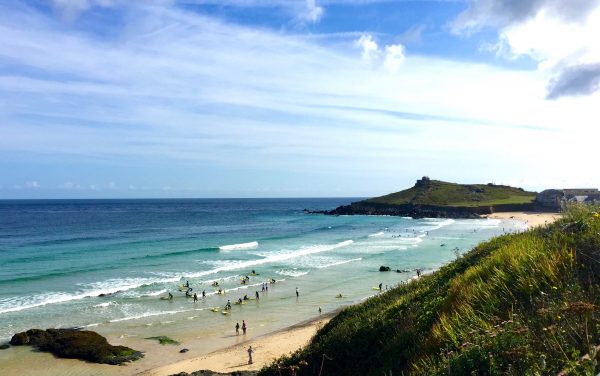

Perched on my surfboard, awaiting the next set of waves, I was suddenly disoriented. The morning sun lit up the pale sand bottom, clearly visible through the transparent, aquamarine water. Surely I was somewhere lush and tropical?
No, I was in fact wearing a 4mm-thick full body wetsuit. I looked at the shore and the dissonance was reaffirmed: in one direction stood a treeless hill of rock and grass capped by a stocky, stone chapel erected in the 15th century. In the other, a renowned modern art museum.
Surfing in Cornwall
Surfing in Cornwall yields one surprise after another. Not just the pleasant shock of pearly white sand and crystalline seas, something I hadn’t associated with cold-water surfing, but also the unexpected joys that follow a morning of wave riding – be they contemplating world class art, exploring medieval fortresses, or dining in chic, farm to table restaurants.
On this nearly cloudless Sunday morning, I was catching waves in St. Ives, a centuries-old Cornish fishing village turned artists’ colony that served as the base from which my husband, daughter, son, and I explored Cornwall’s best surf spots over a week in June.
An outcropping on the final stretch of the Cornwall peninsula (most of St. Ives faces east) sheltered from some of the more vicious gales that batter the point – and that propel surf-worthy waves.
Only St. Ives’s northerly beach, Porthmeor, had waves while we were there and only in the two hours following high tide. Yet, in that brief window of outgoing tide, Porthmeor cove produced picture-perfect peeling rollers. We spent the early morning catching wave after luscious wave.
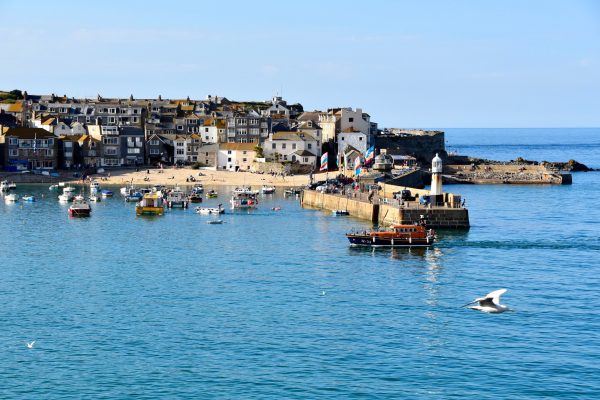
Tidal swings can surpass 20 feet (6 meters) in Cornwall, and by 10 a.m. the receding tide had pulled us back 100 yards (30 meters) from where’d we’d begun, reducing the waves to mere splashes on the shore.
Reluctantly, we paddled in and trod past English families arriving with their beach gear to the ramp leading out of the Parthmeor cove. Surfboards under our arms, we traversed St. Ives’s steep streets towards the Pedn Olva Hotel, an unadorned inn hugging the cliff beyond St. Ives’s fishing harbor.
Once showered, with damp wetsuits draped throughout our petite “family cabin” room, we headed out to explore St. Ives’s artistic treasures. Painters like William Turner sketched St.
Ives’s scenic vistas as early as the 1810s, and they began arriving in greater numbers once the railway was extended into St. Ives in 1877. Musicians, writers, ceramicists and ever more painters followed.
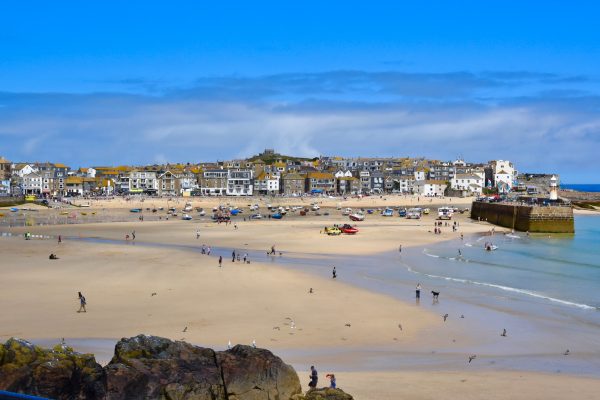
When the celebrated sculptor Barbara Hepworth died in 1975, her St. Ives home became a museum under Britain’s prestigious Tate Gallery – which opened an entire branch in St. Ives in 1993.
It was to the Barbara Hepworth Museum that we headed from our hotel, after first picking up some savory Cornish pastries (called pasties) with untraditional fillings like Thai chicken and spicy chickpea, on St. Ives’s main, pedestrian-only shopping street.
Dozens of modernist bronze, wood and stone sculptures filled the white-walled Hepworth house.
Outside, the sun lit up bold, roughly polished pieces, some over three meters tall, which competed for space with the untidy greenery of the garden, a dizzying mix of native and exotic plants: ferns, scrappy bamboo shoots, and the occasional stunted palm tree.
Tate Gallery St. Ives
From the Hepworth home, we walked back towards Porthmeor Cove, but stayed above sea level, entering the Tate Gallery St. Ives to admire stunning photographs, sculptures, and installations by international artists.
A room designed by Brazilian artist Rivane Neuenschwander was festooned with hundreds of thin, brightly hued ribbons, each bearing a single, distinct wish. Visitors were invited to don one ribbon like a bracelet.
I tied a green ribbon with an ecological aspiration on my wrist, while our teenaged daughter fastened a purple one with a similar hope around her ankle. Our eight-year-old son chose a blue ribbon with dreams of flying through space; my husband opted for red.
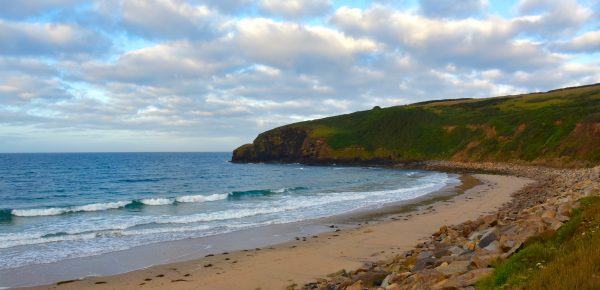
From the ribbon room we reached the final exhibit, which featured small, organic sculptures laid upon sleek, industrial surfaces, reflecting perhaps the juxtaposition of the museum itself, a modern building overlooking the untamed sea.
That exhibit space was shaped like a cove, much like the beach visible through its massive windows. Through the glass, the sea mirrored the cerulean sky, and a mere whisper of clouds hugged the horizon.
Daylong sunshine was not the norm. On previous days, we’d used the unpredictable weather, and the dependable tides, as our organizing principles to plan visits to other areas – like the soaring cliffs of Lands End, Cornwall’s westernmost tip, where our summer layers weren’t enough to keep out the penetrating wind.
I’d found the tourist-ready theatre and snack kiosk a disappointment, but relished the sweeping views of the Celtic Sea below.
We’d also surfed at Gwenvyr Beach, an extensive, undeveloped shore accessed by a winding footpath down a 200-foot (60 meter) escarpment. Although Gwenvyr’s temperature had been balmy, the waves had been too much for our son; so we’d taken turns playing with him on the beach while the rest of us surfed.
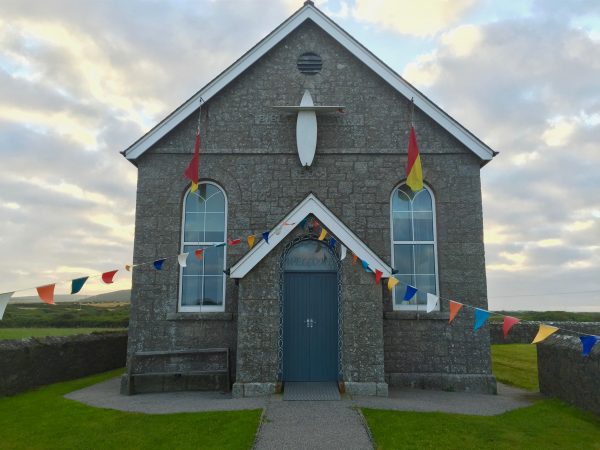
St. Michael’s Mount
On the wettest day of our trip, we’d visited St. Michael’s Mount, an imposing citadel dating to the 12th century perched high atop a tidal island. Sideways rain had battered us as we traversed a stone path visible only at low tide, but intermittent sunshine had warmed us as we’d ascended to the castle itself, where an audio tour took us through a fortress owned by the same family since 1650.
After St. Michael’s, we’d driven to Mousehole, pronounced mau-zel, the tiniest of seaside hamlets, where wee cottages with challenging Cornish names like “Teghyjy” and “Keigwin” boasted gardens and window boxes bursting with vibrant blossoms.
St. Ives’s pedestrian streets had their own well-tended flowerboxes, but after surfing and contemplating art that sunny Sunday, I was too tired to notice them as we meandered back to our hotel.
On the hotel roof deck, we savored “cream tea,” a pot of tea accompanied by fresh scones, cream, and jam. As the salt air, sugar, and caffeine revived me, I noticed cotton ball clouds dotting the late afternoon sky.
Rejuvenated, we meandered back through the harbor in search of the sunset. Inevitably drawn back to Porthmeor Beach, we scaled its chapel-topped knoll, alighting on the stone wall that surrounds the 500-year-old house of worship.
Chains of clouds illumined by the sinking sun made the sky look twice its size; the sea below was inky and expansive.
At that moment, Porthmeor didn’t strike me as a place to frolic in see-through waves. I thought instead of the fishermen who headed out into these frigid waters, seeking a livelihood that sustained the area for centuries.
My morning surf session may have evoked tropical seas; but the evening scene reassured me I was indeed in the North Atlantic.
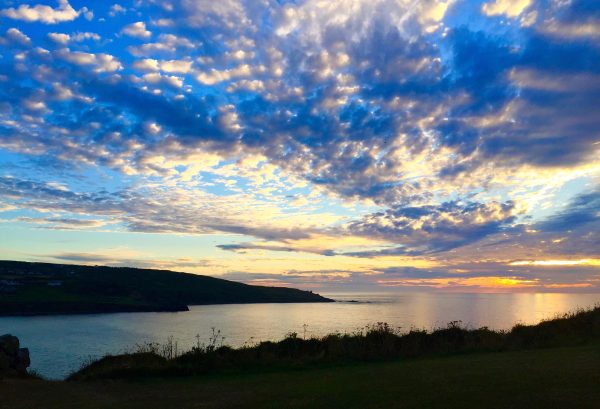
Over a dinner of roasted cauliflower, anchovy sage fritters and spicy monkfish at Porthminster Kitchen on St. Ives’s main harbor, we contemplated the ribbons we’d selected at the Tate. The exhibit had suggested that, once the satiny ribbon fell off, the wish written upon it might come true.
I had tied my jade-toned ribbon on tight; it fell off much later, in a swimming pool thousands of miles from Cornwall. I had a moment to think back to that Sunday in St. Ives.
I don’t know whether the hope inscribed on the ribbon, that we’ll care properly for the earth, will be realized. But I do know that a less ambitious wish – for the perfect summer day – had already come true.
If You Travel to St.Ives:
Arrive
We drove a rental car to St. Ives. However, National Rail trains from London Paddington Station arrive several times a day in St. Ives. They require one change and take 5.5 to 6.5 hours. www.nationalrail.co.uk
Stay
We stayed at the Pedn Olva Hotel. A 29-bedroom hotel built atop a rock between Porthminster Beach and Carbis Bay, with views of both, the Pedn Olva’s friendly service and stellar location make up for the compact guestrooms and soft mattresses. / West Porthminster Beach, St. Ives, TR26 2EA / Tel: 44 1736 796222 / pednolva.co.uk
Dine
Porthminster Kitchen. Excellent farm to table fare and a stunning view of St. Ives harbor. Wharf Road, St. Ives TR26 1LG / Tel: 44 1736 799874 / www.porthminster.kitchen
St. Andrews Bistro. While tasty, the French inspired menu is also rich and pricy. / 16 St. Andrew’s Street, St. Ives TR26 1AH / Tel: 44 1736 797074 / bistrostives.com
Harbour Fish & Chips. The fish is crisp and fresh at this chain store’s St. Ives location. / 4 Wharf Road, St. Ives TR26 1LF / Tel: 44 1736 799295 / harbourfishandchips.co.uk
Pasty Presto. Cornish pasties with traditional and inventive fillings. / 9 Fore Street, St. Ives TR26 1AB / Tel: 44 1736 793470 / www.pastypresto.com
Author Bio: Noelle Salmi has lived on five continents, and surfed on four of them. She is the author of several Frommer’s guidebooks, and her writing has appeared in the San Francisco Chronicle, Jornal do Brasil, Bay Area Parent, Indagare Magazine, Tablet Magazine, and other online and print publications. For more visit www.noellesalmi.com.
- Which Hawaiian Island is Best to Visit? A Guide to Hawaii - July 14, 2025
- Palawan Perfection: Exploring the Philippines’ Last Ecological Frontier - July 13, 2025
- A Journey to Ashland, Oregon’s Shakespeare Festival - July 13, 2025
